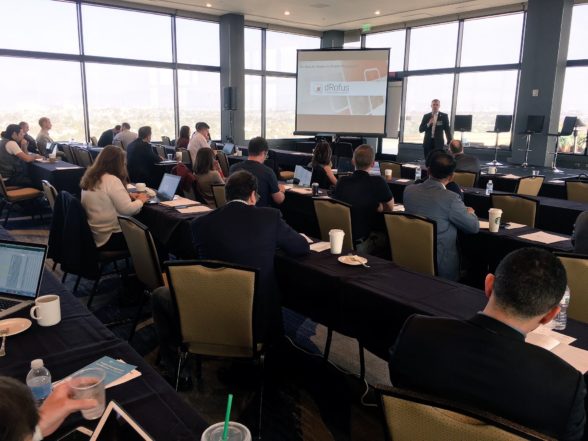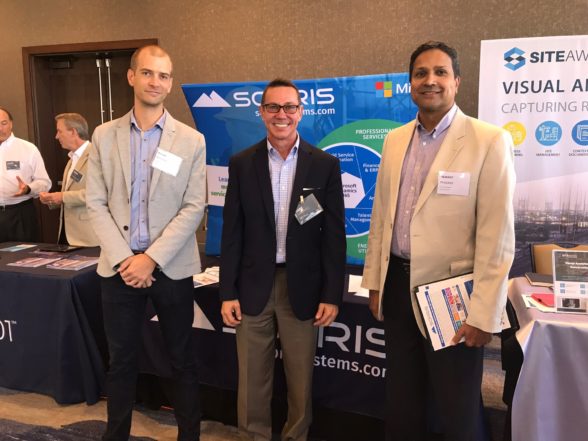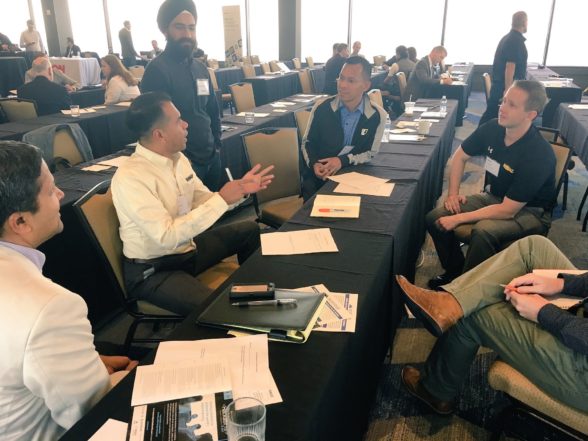
Coming off of the success of the Chicago Project Management event earlier this year, BuiltWorlds hosted its first Project Management conference in L.A. on October 12 at the Marina Del Rey Marriott. Missed it? Here are some key takeaways.
How do we improve/streamline/etc. contracts?

One of the dominant questions addressed at the conference was: How contracts are written? And how should certain services and standards be included?
In response, dRofus’ Brok Howard said that it is essential to do a better job in defining the deliverables. All too often, very little time is spent collecting the requirements and figuring out what clients need. Some of these requirements might include:
- Using cloud collaboration tools
- Using mobile devices and services
- Requiring transparency
- Using the large amount of data collected
- Specifying the delivery method
- Managing risk
Understanding the way in which these requirements interact and influence each other is essential.
How should cloud collaboration work, ideally?
Cloud collaboration has become ubiquitous. A wide range of project management and collaboration software use cloud services to store data and help keep plans and other documents up-to-date. But often, the specific role that cloud collaboration can play is less clear.

Howard of dRofus suggested that as data plays a greater role in informing design, it is essential to explore a common data environment that allows for communication at a database level so that people can find what they need and not disrupt the workflow.
Gary Vadenais of Sopris Systems suggested that Microsoft Azure creates a common cloud-based platform for collaboration that helps to bring the owner into the cycle. For both Sopris System and Frederic Guitton of RedTeam Software, it was clear that connecting the right stakeholders via the cloud was essential. In particular, they explored how software connects the field to the construction office and the accounting department. This helps them to integrate all the elements of the construction process for the customer.
For example, Helix Electric’s $120 million electrical package on the $1.5B new LAX Extension to Tom Bradley International Terminal used cloud-based BIM coordination daily. They were able to extend Autodesk BIM 360 to different tiers of contractors via Autodesk Glue. Given the scale of the project, it was essential to have exceptional coordination, here led by general contractor, Turner Construction.

Mobile devices are now the norm
The use of mobile devices is also intimately connected to the move towards cloud-based services. By connecting different devices to the cloud, people in the field can ensure that they are working off of the most up-to-date plans and documents. In order to do so, however, it is important to ensure connectivity to the internet on the jobsite.
DEWALT’s Jake Olsen shared how they pioneered Wi-Fi for the construction site. This service will support tracking tools, materials, and feedback on how the tools are used to help managers understand if they are being used safely and open the door for broader predictive analytics. Such services will also support the connected jobsite as a whole via tracking equipment, people, and materials.
Open architecture = better solutions with more integration
Both Sopris Systems and RedTeam pointed to the importance of maintaining transparency between systems through open architecture. Doing so will support a common data environment that will allow all the different tools and services to work together, which ultimately requires that tools and solutions support interoperability.
Len Joseph of Thornton Tomasetti shared their work developing Konstru to connect to Excel, ETABS, Rhinoceros, Revit, RAM Structural Systems, and Tekla. The level of interconnectivity was important to the other panelists — Jeff Mays of The Walsh Group, and Randy Starbird of Clune Construction — who discussed their own perspectives as project managers on the Crenshaw/LAX train line extension and interior office space construction, respectively.
Interoperability was also essential to Matt Redman and Rob Wagner of Del Amo Construction who, while talking with Josh Newland of Procore about adopting Procore as their project management software, shared their desire for a single, comprehensive dashboard that can take in all the data and make it actionable.

What to do with all that data
An increasing amount of data is collected as companies adopt these methods and new technologies. Andrew Dennison of Uplift Data Partners and Philip Lorenzo of StructionSite discussed the ways in which drone and 360 degree photography are used in the project management process. A tremendous amount of data can be extracted from image capture, which goes beyond just risk mitigation — it can be used to understand material supply, earth movement, and people, goods, and equipment tracking, in addition to driving schedule updates using machine learning.
Everyone’s talking about prefab and project delivery

The manner in which projects are delivered to the client brings together many of the concerns shared by the various presentations. Gordon Stott of Connect Homes shared the difference in delivery method between modular and site building. In particular, he discussed how taking the custom out of custom design by requiring the client to order off a menu makes it possible to streamline the process. Further, by getting one particular building model approved by building inspectors, Connect Homes reduced the delivery time, by eliminating project approval on a one-off basis.
Beyond the fabrication technique, the manner in which a building is turned over to an owner presents unique challenges for the broader project management process. The question arises as to what information is given to the owner and how they translate that information into their building management system.
Cleve Adams of Site 1001 and Randy Smith of Gilbane shared how they streamlined the turnover process through Gilbane’s Enhanced Transition to Operations system integration with Site 1001 sensors, which can take the pulse of the building through understanding the performance of all the building systems.

How to mitigate risk through collaboration
As these approaches are implemented in new projects, risk management is essential. TJ Glover of Helix Electric discussed how they are using Autodesk Live VR to help superintendents visualize the building to make sure that the various elements are aligned. They also discussed ways in which they are reducing risk by fabricating directly from the BIM model.
Scott Stoddard of KPMG shared highlights of their 2017 Global Construction Survey that explored the distinction between optimizing vs. changing paradigms. In addition, it looked at the role human talent plays in project delivery and concerns that the construction industry is losing talent to other industries.
Investing in built tech is hot
With all these ideas for improving the project management process, how can we make innovation happen? Al Goldstein of Avant and Brendan Wallace of Fifth Wall Ventures discussed the influx of investment in built industry innovation.

Wallace built a $250M investment fund to support real estate innovation by getting the largest real estate players to be limited partners. He worked collaboratively with CBRE, Equity Residential, Hines, Host Hotels & Resorts, Lennar, Lowe’s, Macerich, Prologis, Rialto, and Rudin Management to de-risk the go-to-market strategy of the companies they invest in.
Some of the top trends included: 1. Real estate as a service and 2. the contrast between intermediating and disintermediating as we watch the largest real estate-like platforms no longer own assets as they help those that do transition from a business-to-business model and to a business-to-consumer model.
While discussing this work, Wallace challenged those considering whether to invest in a new technology to ask, “What is the cost of not investing?”
And what a relevant question to ask. This should and will be an essential question for all of us to consider as we consider what technologies, services, and tools to adopt in managing and delivering the next project.
















